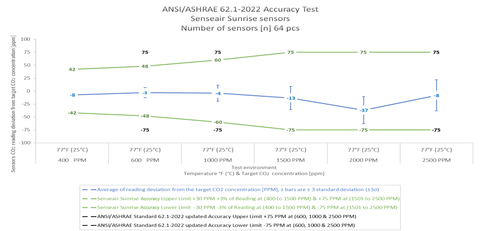
Sunrise CO2 Sensor from Asahi Kasei’s Subsidiary, Senseair, Unveils New Technology at AHR 2024 for Energy Efficiency and Air Quality
Published by Todd Bush on January 19, 2024
NEW YORK & CHICAGO--(BUSINESS WIRE)--Senseair, a leader in Non-Dispersive Infrared Technology (NDIR) and a subsidiary of the Asahi Kasei Group, introduces their Sunrise CO2 sensor to the market. Based on an internal study, the technology is shown to potentially optimize energy efficiency and enhance indoor air quality, which could contribute to a healthier indoor environment. This product will debut at the upcoming AHR 2024 conference focused on HVACs in Chicago, Illinois, on January 22.
![Production verification test at 1000[PPM] CO2 concentration](https://mms.businesswire.com/media/20240119756322/en/2003191/4/distributionofSunrisesensorduringverificationtest.jpg?download=1)
Production verification test at 1000[PPM] CO2 concentration.

Senseair Sunrise sensors accuracy test based on the latest addition, Addendum ab, to the ANSI/ASHRAE Standard 62.1-2022.
>> In Other News: Asahi Kasei Establishes Framework for Investment in Startups Focused on Carbon Neutrality
CO2 sensors play a vital role in demand-controlled ventilation (DCV) systems by ensuring that ventilation systems respond precisely to real-time conditions. As DCV systems are often placed near ventilation ducts where vibration cannot be avoided, the performance of CO2 sensors must be unaffected by the vibration.
The latest ANSI/ASHRAE Standard 62.1-2022 Addendum ab has introduced new precision criteria for CO2 sensors, specifically at a concentration of 2500 ppm. This requirement emphasizes the importance of choosing established CO2 sensor suppliers known for their quality and experience in the field. These new demands necessitate sensors with a robust standard of performance and accuracy.
According to ASHRAE Addendum ab, "CO2 sensors shall be certified by the manufacturer to be accurate within ±75 ppm at concentrations of 600, 1000, and 2500 ppm when measured at sea level at 77°F (25°C). Sensors shall be factory-calibrated and certified by the manufacturer to require calibration not more frequently than once every five years. Upon detection of sensor failure, the system shall provide a signal that resets the ventilation system to supply the required minimum quantity of outdoor air (Vbz) to the breathing zone for the design zone population (Pz)."
“Senseair, who is part of the Asahi Kasei Microdevices group, combines our industry expertise with emerging technology,” states Chris Baltar, Vice President of Business Development for Asahi Kasei Microdevices’ branch in San Jose (AKM Semiconductor). “We have over 30 years of expertise in NDIR technology, and we continue to push limits to produce high-quality, cost-effective sensors.”
The Sunrise CO2 sensor has undergone testing in both production and development departments to ensure comprehensive insights and performance metrics to meet the highest standards. Visitors will be able to experience this firsthand at the upcoming AHR 2024 tradeshow at booth S6352. For more information on Senseair’s products, visit: https://senseair.com/
About Asahi Kasei
The Asahi Kasei Group contributes to life and living for people around the world. Since its founding in 1922 with ammonia and cellulose fiber businesses, Asahi Kasei has consistently grown through the proactive transformation of its business portfolio to meet the evolving needs of every age. With more than 48,000 employees worldwide, the company contributes to a sustainable society by providing solutions to the world's challenges through its three business sectors of Material, Homes, and Health Care. Its Material sector, comprised of Environmental Solutions, Mobility & Industrial, and Life Innovation, includes a wide array of products from battery separators and biodegradable textiles to engineering plastics and sound solutions. For more information, visit https://www.asahi-kasei.com/.
Asahi Kasei is also dedicated to sustainability initiatives and is contributing to reaching a carbon-neutral society by 2050. To learn more, visit https://www.asahi-kasei.com/sustainability/.
Subscribe to the newsletter
Daily decarbonization data and news delivered to your inbox
Follow the money flow of climate, technology, and energy investments to uncover new opportunities and jobs.
Latest issues
-
CCS Just Got Cheaper Than Anyone Expected
Inside This Issue 🧪 Shrinking the CCS Energy Penalty: A Molten Borate Breakthrough Promises Viability for Hard-to-Abate Canadian Oil & Gas 👤 Syntholene Energy Corp Appoints Former CEO of Carbo...
-
The CO₂ Pipeline Everyone Said Couldn’t Happen
Inside This Issue 🛠️ Tallgrass Found the CO2 Pipeline Formula Others Missed 🚂 HyOrc & Zeltech Advance Practical Locomotive Retrofit Pathway as U.S. Rail Emissions Face Growing Scrutiny 💰 Secre...
-
How 45Q Credits Revived This Troubled $9B Megaproject
Inside This Issue 💰 How 45Q Credits Revived This Troubled $9B Megaproject 🍁 Commencement of First Phase Operations for a Carbon Capture and Storage (CCS) Project in Canada 🤝 Haffner Energy Secures...
Company Announcements
-
K2 Pure Solutions Breaks Ground On Commercial Low-Carbon Hydrogen Facility In Pittsburg, California
Expansion Adds High-Pressure Hydrogen Production Engineered to Meet California Clean-Fuel Standards, with PACC Serving as Exclusive Marketing & Distribution Partner Facility Expansion: K2 Pur...
-
RABA Switches Entire Bus Fleet To B20 Biodiesel Blend
The new mix offers an estimated 15% reduction in carbon dioxide emissions. The new diesel mixture is a blend of 20% renewable biodiesel and 80% petroleum diesel that can be dropped in without any ...
-
The combined airlines will take the first deliveries of Hawaiʻi-made SAF in early 2026. Investment enables SAF production for more sustainable future flying, diversifies Hawaii's fuels industry, s...
-
Montreal, Quebec--(Newsfile Corp. - December 18, 2025) - Québec Innovative Materials Corp. (CSE: QIMC) (OTCQB: QIMCF) (FSE: 7FJ) ("QIMC" or the "Company") is pleased to report new high-grade soil-g...